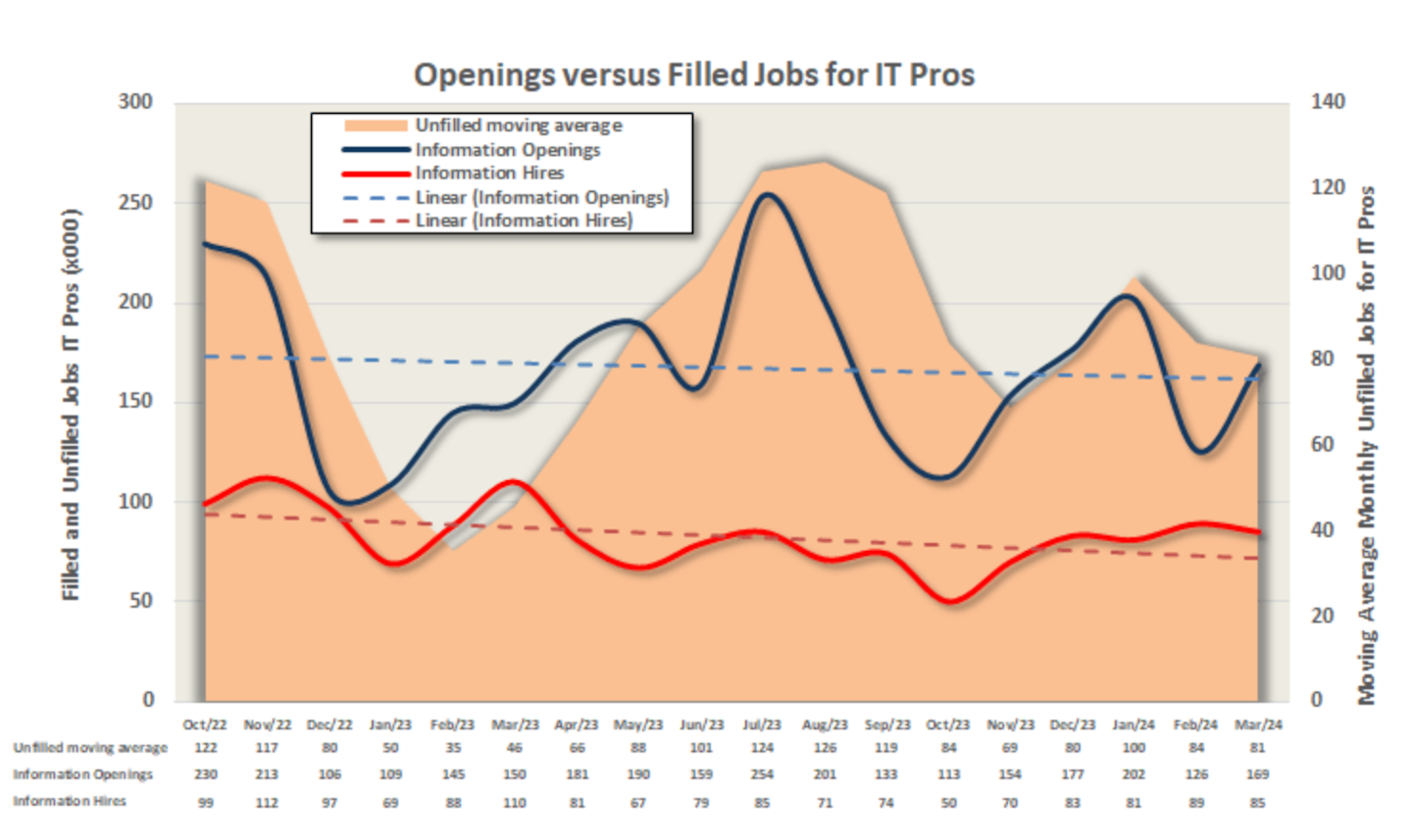There are around 1.7 million open tech positions worldwide in 2024. For the US, the estimated number of active tech job postings is 438,000. The number of available tech jobs in Japan is 350,000. For Europe, the figure rounds out at 960,000. Israel, Canada, India, Brazil, and Australia also contribute jobs to the grand total.
How available jobs in technology worldwide are estimated
The grand total was calculated by adding up each market’s data. Europe was the most multifaceted region. The European overall figure was calculated based on CompTIA’s account of 950,000 new tech positions across European countries for 2022, the addition of 10,000 new tech jobs in 2023 reported by the State of European Tech, and the claim that barely 20% of European tech companies are expected to hire for the first part of 2024. The Japanese figure comes from an estimate from Japan’s Ministry of Economy, whose whitepaper was originally digested by a software engineer based in Japan.
If you want to compare these figures against the global workforce, here are some facts: more than 1.25 billion people are “information workers,” meaning people who work with a computer or phone every day. Out of that, in 2024, the global developer population will be 28.7 million—which means only about 2.3%, of information workers are developers. Only in the United States are there around 1.7 million software developers—meaning the market expects to hire a “United States” worth of tech workers all over again.
Using these figures, we can reason that, out of approximately 17 tech workers, there is one new tech job opening in 2024.
This is an estimative figure that includes open roles in several markets. Most of these roles are in three of the biggest markets—the United States and the rest of North America, Europe, and Japan—and, many times, the authorities relaying figures for those markets also rely on estimations by third parties. Most of the posted jobs can be carried out in English.
The US leads the global economy in expected IT hirings from April to June 2024.

Discussing the current tech job market
The tech job market has seen a period of intense hiring, especially while other sectors held back. While the rhythm has slowed down recently, job openings for tech roles are still increasing. Many developments are consistent with this market slowdown: the tech layoffs, the hiring freezes, and tech salaries going down compared to pandemic levels all agree with this arc of events. Still, with tech job openings outpacing all other jobs in the United States, there's a clear bottom line: it's still an excellent time to work in tech, even in Europe. We've crunched the numbers to show you why.
How many jobs are available in the US?
The US tech job market is growing steadily. In April 2024, employers posted 175,000 new jobs (for any trade). Even if the vacancies for tech jobs dwindled, the total number of tech active listings is an estimated 438,000.

While there have been some recent declines in overall tech employment rates, the volume of open positions in the sector is still considerably high. There are consistently more open IT jobs than filled positions in the US, suggesting a high demand for skilled tech professionals. According to IT consulting firm Janco Associates, the unfilled moving average of IT jobs has been steadily increasing since October 2022, with its peak in September 2023 at around 254,000 open IT jobs.

Looking ahead, projections suggest sustained expansion. The CompTIA State of the Tech Workforce Report 2024, based on the analysis of data collected by the US Bureau of Labour Statistics, anticipates the tech workforce to grow twice as fast as the overall US workforce from 2022 to 2032. This translates to roughly 350,000 new tech jobs created annually to meet replacement needs and accommodate industry expansion.

Tech occupations like data science, cybersecurity, and software development are expected to see considerable growth, with projected increases exceeding the national average. For smaller and more niche markets like web developers and digital designers, the US Bureau of Labour Statistics projects overall employment to grow 16% from 2022 to 2032, which translates into around 19,000 new jobs created each year, on average, over the decade—not negligible for a so-called oversaturated career path. For the broader “software developers” category, the estimate is that there will be around 154,900 new job openings yearly in the next few years.

Europe’s growing tech job market
Europe's tech sector has become a popular destination for IT talent, attracting skilled workers from both within and outside the region. While there has been a recent slowdown in hiring, the overall trend remains positive. In the first half of 2024, 55% of the 900 companies surveyed said they'd like to keep their current workforce.
The European tech workforce has grown steadily during the past five years, rising from barely over 750,000 tech workers to a current total of approximately 2.3 million. According to a report by the State of European Tech, there was a net increase of 10,000 new tech workers across Europe in 2023.
Europe's strong track record in tech startup activity is also helping to drive demand. For the past five years, the number of founders starting new tech startups in Europe has consistently outpaced their counterparts in the US. As these startups grow, they will need more skilled professionals to fill key roles, which calls for the creation of a significant number of new tech jobs across Europe in the coming years.

The following graph shows the employment growth in high-tech occupations projected across EU27 countries for 2022–2035 (in %):

The rise of emerging technology jobs
Some industry reports highlight a growing trend: the rise of specialised tech roles focused on emerging technologies. AI experts are at the forefront, developing algorithms and machine learning models that help automation and speech recognition. This includes specialists in AI model engineering, data curation, and AI content creation. Careers in augmented reality, virtual reality, and blockchain are also gaining traction, especially thanks to the metaverse build-up.
The same report indicates that companies will pay a premium for tech professionals who can build out infrastructure. This could be explained because, without reliable databases, networks, and cloud platforms, organisations cannot scale any of the other technologies, including AI and data analytics.
Spatial technologies within the “industrial metaverse” are creating jobs in digital twins, augmented work instructions, and collaborative digital spaces. According to a recent report from an audit firm, 92% of manufacturing executives surveyed are actively involved with the industrial metaverse, either experimenting with or implementing metaverse-related applications, with an average of over six initiatives underway (it does seem like a very high figure, though; hard to say how many of those executives will actually carry out metaverse projects). These executives anticipate positive outcomes, expecting a potential improvement of 12% to 14% in key areas like sales, production, and product quality for the coming years.

Tech unemployment rate
The US Bureau of Labour Statistics (BLS) reports a positive trend in the tech sector. The tech unemployment rate dropped from 3.5% in February 2024 to 3.0% in March 2024, alongside the creation of 203,000 new tech jobs. According to the BLS, it remains slightly lower than the overall US unemployment rate, which has ranged between 3.7% and 3.9% since August 2023.
According to Janco Associates, the unemployment rate for March 2024 was 3.5% (instead of 3.0%, as BLS reports). For April 2024, they estimated an increase of one and a half points (5.0%), which translates into nearly 128,000 unemployed IT professionals. At the same time, CompTIA announced that the unemployment rate for US tech workers in April 2024 ticked down to 2.8%. These variations in the numbers are probably due to CompTIA’s analysis separating jobs at tech companies (which can include workers in sectors like retail and marketing), from IT jobs at firms outside the tech sector. The group reported that tech jobs throughout the economy fell by 0.3% in April 2024.

While aggregated data exclusively for tech professionals in Europe is challenging to come by, isolated figures for IT professionals, which consider a wide range of tech jobs, offer a positive outlook. The unemployment rate for those with IT education has steadily decreased recently, falling to 5.8% in 2022, compared to 8.8% in 2016. This translates into the EU labour force in possession of an IT education rising from 2.5 million people in 2016 to 3.2 million by 2022. This trend suggests an increasing demand for skilled tech workers across Europe, even though the most recent data available might be a couple of years old.

How does the future of the tech job market look?
While some economists predict a slight slowdown in global tech job growth compared to 2023 due to factors like projected dips in GDP, the overall outlook remains positive. Recent tech industry layoffs, particularly in major companies, are likely to level off in 2024. This means a return to a more predictable hiring scenario, with a focus on skilled professionals rather than mass hiring sprees.
Now, if we concentrate on the software engineers’ job market future and examine the graph from DevQuarterly, we see a trend that reflects this broader picture. The graph shows a generally positive growth rate in developer job openings, with more weeks experiencing increases than decreases. This suggests a sustained demand for developers, even with potential fluctuations in hiring pace, and paints a picture of a lively, fast-paced and growth-oriented future for the tech market in the years to come.

Pursue a career in IT as a software engineer
The US Bureau of Labour Statistics projects that the tech field will experience a steady turnover of about 6%, requiring about 377,500 new tech workers annually, on average, over the next decade. Data predicts the European tech job market will behave similarly in the coming years. This suggests it’s still an excellent time to get a job as a software engineer.
You can start your search on our platform. WeAreDevelopers helps software engineers find jobs at top European companies. Join us to learn about our job listings, check our job board for the most up-to-date opportunities, and begin your career in IT as a software engineer. Best of luck!









.webp?w=720)


